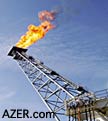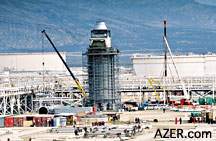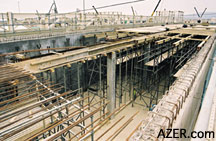|

Spring 2005 (13.1)
Pages
86-88
BP Current Developments
Production Begins at Central Azeri
by Tamam
Bayatli
  Left: Central Azeri platform view from helicopter. Left: Central Azeri platform view from helicopter.
First Oil production
from the Central Azeri development began on February 13, 2005,
as part of the Azeri - Chirag - Gunashli (ACG) field, in the
Azerbaijan sector of the Caspian Sea.
President Ilham Aliyev of the Republic of Azerbaijan inaugurated
the First Oil from the newly built Central Azeri production,
drilling and quarters platform at an offshore ceremony on February
18. This event signaled the official beginning of oil production
from the Azeri - Chirag - deepwater Gunashli (ACG) Full Field
Development.
Located in approximately 128 metres of water 100km east of Baku,
Central Azeri (CA) production began from the first of 10 pre-drilled
production wells. Two weeks later on February 28, the second
well was tied in. These two wells were previously completed,
tested and suspended. They have a production potential in excess
of 30,000 barrels of oil a day each and will be progressively
ramped up into the facilities. These first two wells are a subset
of the 10 pre-drilled production wells. BP as operator of the
field development plans to bring all 10 wells into production
during 2005.
Production will increase through 2005 as the other pre-drilled
wells are brought online, prior to further platform drilling
over the coming years. Total production from Central Azeri is
forecast to be some 35 million barrels in 2005 (equivalent to
an average of 93 000 barrels of oil a day).
"The start up of Azeri is an exciting moment both for Azerbaijan
and BP as operator of the ACG Project," said David Woodward,
BP's Associate President in Azerbaijan. "It signals the
beginning of oil production from the ACG Full Field Development,
and the culmination of many years of planning, construction and
operations delivery."
  Left: President Ilham Aliyev opens the tap
for the First Oil from Central Azeri Platform. BP Azerbaijan
President David Woodward and SOCAR President Natig Aliyev look
on. Left: President Ilham Aliyev opens the tap
for the First Oil from Central Azeri Platform. BP Azerbaijan
President David Woodward and SOCAR President Natig Aliyev look
on.
"A team
of more than ten thousand people, across many countries has been
working on this project over the past three and a half years.
I would like to congratulate the government, our partners, employees,
all the contractors and suppliers and every person involved in
this achievement."
The Central Azeri facilities comprise a 48 - slot production,
drilling and quarters (PDQ) platform, a 30 - inch oil pipeline
and a 28 - inch gas pipeline from CA to the Sangachal Terminal,
expansion of the existing onshore terminal at Sangachal. The
development is designed to process 420,000 barrels of oil a day.
In addition to the PDQ, a compression and water injection platform
(C&WP) will be installed in Central Azeri in the third quarter
this year and bridge - linked to the PDQ to create a major offshore
complex encompassing accommodation, drilling, production, processing,
compression and re-injection facilities. Oil from Central Azeri
will be transported via a new 30 - inch subsea pipeline to the
onshore Sangachal Terminal, which has been expanded to receive
the additional oil volumes from the ACG field, including three
newly built crude storage tanks. Processed oil from Sangachal
will initially be transported to market via existing export routes,
and through new export routes once the Baku - Tbilisi - Ceyhan
(BTC) pipeline is operational later this year.
Gas produced from Central Azeri, beyond that used for reservoir
pressure maintenance and fuel, will be exported via the new 28-inch
subsea pipeline into the Sangachal Terminal gas processing facilities.
From there the gas will be transported, via a newly built gas
export pipeline into the Azerigas system for domestic use.
The ACG Production
Sharing Agreement (PSA), signed in September 1994, covers the
30-year development of the Azeri - Chirag - Gunashli contract
area. It is estimated that 5.4 billion barrels of oil will be
recovered during the PSA period. The field is being developed
in several phases: Chirag has been producing since 1997 as part
of the Early Oil Project (EOP). This has now been followed by
Azeri Project Phase 1 - Central Azeri production. Successive
phases include West Azeri and East Azeri as Azeri Project Phase
2, scheduled to come on stream in 2006 and 2007 respectively,
with ACG Phase 3 - deepwater Gunashli, now sanctioned and expected
to begin production in 2008.
Above: 1. Hot oil heater radiant
shell, convection box, internal tubing and stack flange erected.
2. Construction of Local Switch Room 4.
The export of
Central Azeri crude oil started from the Sangachal terminal on
March 3 and took just over two weeks to reach Sangachal terminal
where it was treated to achieve the required specifications before
it entered the export system. Oil from Sangachal will initially
be transported to market via existing export routes, and through
new export routes including the Baku - Tbilisi - Ceyhan (BTC)
pipeline, which will become operational later this year.
BP Invests Locally
  BP
recently signed an agreement with the local company BMI - 2 for
construction of a new fabrication workshop and upgrade of its
facilities. Under this agreement, BP will provide them with a
$245,000 loan. The loan covers technical assistance and investment
in the local company and is aimed at supporting BMI - 2 in its
efforts to align its work practices and capabilities with international
standards. Both BMI - 2 and BP have a common interest in developing
local capacity in the fabrication services area. BP
recently signed an agreement with the local company BMI - 2 for
construction of a new fabrication workshop and upgrade of its
facilities. Under this agreement, BP will provide them with a
$245,000 loan. The loan covers technical assistance and investment
in the local company and is aimed at supporting BMI - 2 in its
efforts to align its work practices and capabilities with international
standards. Both BMI - 2 and BP have a common interest in developing
local capacity in the fabrication services area.
The selection of BMI - 2 for this investment project was conducted
by BP through its engineering contractor AMEC. The selection
process included visiting seven local companies and inspecting
their facilities. Before making the final decision to invest
in this company, BP together with AMEC carried out a rigorous
market analysis and BMI - 2 was seen as the most promising candidate.
The selection was also based on two additional factors: BMI -
2 is a 100 percent privatized local company that has applicable
facilities to provide BP and partners with medium-sized fabrication
services. It also has the potential to expand with appropriate
technical assistance and investment.
This is viewed as a pilot project for a future supplier financing
initiative that BP is currently looking into. The success of
this project will depend on BMI-2's ability to perform in accordance
with both high technical and non-technical standard.
Community Involvement

Above: The new community clinic
opened in Aran (Yevlakh) which was funded by the Community Investment
Program of the Baku - Tbilisi - Ceyhan (BTC) and Southern Caspian
Pipeline (SCP).
The Azerbaijan
International Operating Company (AIOC) has continued to support
local schools around the Sangachal Terminal. As part of this
support, AIOC recently implemented a project, which covered 160
sixth graders from all of the four schools located in the Garadagh
district where the terminal is based, including three schools
for children from internally displaced families from the Karabakh
war, temporarily living in the Sahil settlement and the Umid
refugee camp. The project was aimed at supporting the schools
in their efforts to improve the standards of the teaching process
and to provide more opportunities for schoolchildren from needy
families to visit places of interest in Baku and tour children's
entertainment facilities.
The project started on January 11 and lasted until the beginning
of February when children were taken on educational trips to
the National Zoo. Altogether eight 7-hour trips were arranged
with groups comprised up to 28 children per trip, accompanied
by their schoolmasters and representatives of the Parents' Councils
and AIOC.
The project covered children who represented the Sangachal Village
School No 222, and the refugee camp schools, which include Umid
School No 294, Lachin District School No 7, Fuzuli District School
No 49. On March 16, the Baku-Tbilisi-Ceyhan (BTC) oil export
and South Caucasus Pipeline (SCP) gas export pipeline projects
opened a newly constructed clinic in the Aran settlement of the
Yevlakh district. This was part of their Community Investment
Programmes (CIP). The clinic will serve as a new source of high
quality health care for more than 5,000 residents of the central
part of the Yevlakh district.
Construction of the new clinic started in December 2004 and lasted
three months. Local residents were involved in the construction
works and a medical staff of four doctors, two midwives and five
nurses were provided with permanent jobs.
The four - room facility offers comprehensive primary health
care services including: ob-gyn, adult medicine, pediatrics,
laboratory, health educational and dental screening. In addition,
special electro-cardiogram and laboratory training were arranged
in Baku for the medical staff of the clinic.
"Prior to the founding of this clinic, we did not have access
to proper medical services," said one of the Aran residents.
"We used to have to travel to the district hospital for
many tests and services. It was so inconvenient, especially for
older people."
"We are so pleased to be able to expand the availability
of proper medical care here in Aran," said Elmi Gadimov,
the chief doctor at Aran. "The need for care is tremendous
and is growing every day. This new clinic is a wonderful option
for the Aran residents. They can now receive high quality health
care without leaving the settlement."
Access to health care is a significant problem in some of the
districts of Azerbaijan. The people in need of medical care often
do not receive proper treatment because of limited medical facilities
and limited means of transportation to district hospitals. Many
of the facilities that do exist are not in good condition and
lack basic laboratory and other medical equipment.
To help address these regional health care problems, BTC/SCP
started a two-year Integrated Community Health Development Project
(ICHDP) in July 2003 as part of their Community Investment Program
(CIP). The project is implemented by International Medical Corps
(IMC) which is successfully working in communities in all regions
along the two pipelines. As a result of this project, 20 clinics
have successfully been constructed and rehabilitated, and more
than 40 physicians have acquired new skills as well as being
provided with necessary medical equipment.
Back to Index AI 13.1 (Spring
2005)
AI Home
| Search | Magazine
Choice
| Topics
| AI Store | Contact us
Other Web sites
created by Azerbaijan International
AZgallery.org | AZERI.org | HAJIBEYOV.com
|






